
Australian Wireless Notice
WARNING!
Switch off this device whenever in an area with a potentially explosive atmosphere
(i.e., service stations, chemical plants, etc.).
Singaporean Wireless Notice
●
Switch off your cellular telephone when in an aircraft. The use of cellular telephones in an aircraft
may be dangerous to the operation of the aircraft, disrupt the cellular network, and is illegal. Failure
to observe this instruction may lead to suspension or denial of cellular services to the offender, or
legal action or both.
●
Users are advised not to use the equipment when at a refueling point.
●
Users are reminded of the need to observe restrictions on the use of radio equipment in fuel depots,
chemical plants or where blasting operations are in progress.
●
The use of the Alert device to operate a vehicle’s lights or horn on public roads is not permitted.
●
It is advised that a handheld microphone or telephone handset should not be used by the driver
while the vehicle is moving, except in an emergency. Speak only into a fixed, neck slung or clipped-
on microphone when it would not distract your attention from the road.
●
As with other mobile radio transmitting equipment, users are advised that for satisfactory operation
of the equipment and for the safety of personnel, it is recommended that no part of the human body
be allowed to come too close to the antenna during operation of the equipment.
●
This device has been designed to comply with applicable requirements for exposure to radio waves
based on scientific guidelines that include margins intended to assure the safety of all people,
regardless of health and age. These radio wave exposure guidelines employ a unit of measurement
known as the Specific Absorption Rate (SAR). Tests for SAR are conducted using standardized
methods with the phone transmitting at its highest certified power level in all used frequency bands.
The SAR data information is based on CENELEC’s standards EN50360 and EN50361 which use
the limit of 2 Watts per kilogram (W/kg) averaged over 10 grams of tissue. The highest SAR value
for this model phone when tested is as follows:
●
GSM900: 0.158 W/kg (10g)
●
DCS1800: 0.387 W/kg (10g)
192
Chapter 22 Regulatory Notices
ENWW
Summary of Contents for iPAQ
Page 1: ...Additional Product Information User Guide ...
Page 9: ...1 Registering the iPAQ ENWW 1 ...
Page 11: ...2 Phone ENWW 3 ...
Page 39: ...3 Connections ENWW 31 ...
Page 66: ...4 Global Positioning System GPS 58 Chapter 4 Global Positioning System GPS ENWW ...
Page 78: ...5 Security 70 Chapter 5 Security ENWW ...
Page 86: ...6 Camera select models only 78 Chapter 6 Camera select models only ENWW ...
Page 92: ...7 HP Photosmart Mobile 84 Chapter 7 HP Photosmart Mobile ENWW ...
Page 97: ...8 HP Photosmart Premier ENWW 89 ...
Page 100: ...9 HP Image Transfer 92 Chapter 9 HP Image Transfer ENWW ...
Page 103: ...10 Messaging ENWW 95 ...
Page 116: ...11 Java MIDlet Manager 108 Chapter 11 Java MIDlet Manager ENWW ...
Page 119: ...12 Learning The Basics ENWW 111 ...
Page 135: ...13 Calendar ENWW 127 ...
Page 141: ...14 Contacts ENWW 133 ...
Page 151: ...15 Entering Text ENWW 143 ...
Page 157: ...16 Notes ENWW 149 ...
Page 161: ...17 Expansion Cards ENWW 153 ...
Page 166: ...18 Synchronizing 158 Chapter 18 Synchronizing ENWW ...
Page 170: ...19 Tasks 162 Chapter 19 Tasks ENWW ...
Page 175: ...20 Product Specifications ENWW 167 ...
Page 181: ...21 Microsoft Programs ENWW 173 ...
Page 188: ...22 Regulatory Notices 180 Chapter 22 Regulatory Notices ENWW ...
Page 204: ......





































